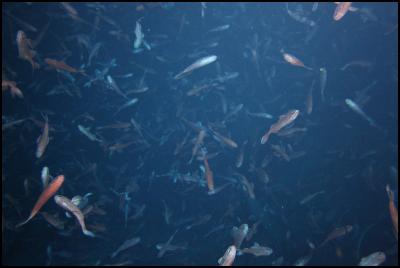Orange roughy fishers want conservative catch limits
News release
27 September
2012
Orange roughy fishers want conservative
catch limits for new season
Fishing companies have asked the government to retain the current conservative catch limits for orange roughy in the season about to start. (1 Oct Eds) This is despite increasing fish numbers and the discovery of more orange roughy on two of the main fishing grounds.
The Deepwater Group Ltd’s CEO, George Clement, says, “The quota owners’ decisions to reduce their orange roughy catches in the past have worked. Numbers of orange roughy have increased as a result, and quota owners wish to see them continue to increase to further enhance these fisheries.”

Photo of orange roughy taken
above Graveyard hill on the Chatham Rise by CSIRO scientists
during their acoustic biomass survey in June 2012.
He noted that recent scientific assessments for two of the main fishing grounds, one on the West Coast’s Challenger Plateau, and the other on the Chatham Rise, confirmed more orange roughy are available and that higher catches could be sustainably harvested.
For a third orange roughy fishing ground (on the mid-east coast off Central New Zealand)where scientific information is more uncertain, George Clement says fishing companies have also demonstrated their commitment to long-term responsible fisheries management by agreeing not to fish 25% of the available catch limit, to increase numbers of orange roughy there as well.
“The Ministry for Primary Industries estimate that orange roughy will continue to increase at the current catch levels. More young fish are coming into these fisheries, which is good for the future. We presently harvest around 3,400 tonnes from these three areas, and this could increase to around 7,200 tonnes when the stock sizes are optimal,” George Clement says.
George Clement acknowledges the significant challenges in counting orange roughy and in estimating sustainable catch levels.
“Getting this right is essential. The seafood industry, with government support, has pioneered new acoustic survey techniques with scientists from New Zealand, South Africa and Australia. NIWA scientists have established that there are more orange roughy in the water than they previously thought.
“Australian CSIRO scientists, using their specialised acoustic equipment that can separate orange roughy from other species, have provided more certainty to these numbers. As a result, reliable, almost real-time information on the location and how many orange roughy there are, are now available, not to mention clear underwater photos.
“This new scientific research indicates that catches could almost double and still be sustainable. At this time, the seafood industry wants orange roughy numbers to increase and has asked that the current conservative catch limits be retained for another year.
“The current catch limits ensure that, for every orange roughy we catch, at least another 45 are left in the sea for the future. The Ministry for Primary Industries has calculated that there are around 140 million adult orange roughy in New Zealand’s waters and their numbers are increasing. This means that we can be certain that there will always be plenty of orange roughy in our waters to harvest in future years,” Clement says.
A number of New Zealand fisheries have now been assessed to meet the standards set by the Marine Stewardship Council (MSC), a programme that independently establishes whether a fishery is sustainably managed.
“We started MSC certification for orange roughy
some years ago and, working alongside MPI, we have
progressively improved our orange roughy management. MSC
certification is recognised around the world as the ‘gold
standard’ for sustainable fishing and it is not easy to
meet all of their standards, so it may take further time
before it’s all signed off. When we do, we know that this
certification will be recognised in our main orange roughy
export markets – ensuring our customers can continue buy
with confidence,” George Clement concluded
ENDS


 Business Canterbury: Urges Council To Cut Costs, Not Ambition For City
Business Canterbury: Urges Council To Cut Costs, Not Ambition For City Wellington Airport: On Track For Net Zero Emissions By 2028
Wellington Airport: On Track For Net Zero Emissions By 2028 Landcare Research: ANZAC Gall Fly Release Promises Natural Solution To Weed Threat
Landcare Research: ANZAC Gall Fly Release Promises Natural Solution To Weed Threat NZ Anti-Vivisection Society: Auckland Rat Lovers Unite!
NZ Anti-Vivisection Society: Auckland Rat Lovers Unite! University of Canterbury: $1.35 Million Grant To Study Lion-like Jumping Spiders
University of Canterbury: $1.35 Million Grant To Study Lion-like Jumping Spiders Federated Farmers: Government Ends War On Farming
Federated Farmers: Government Ends War On Farming



